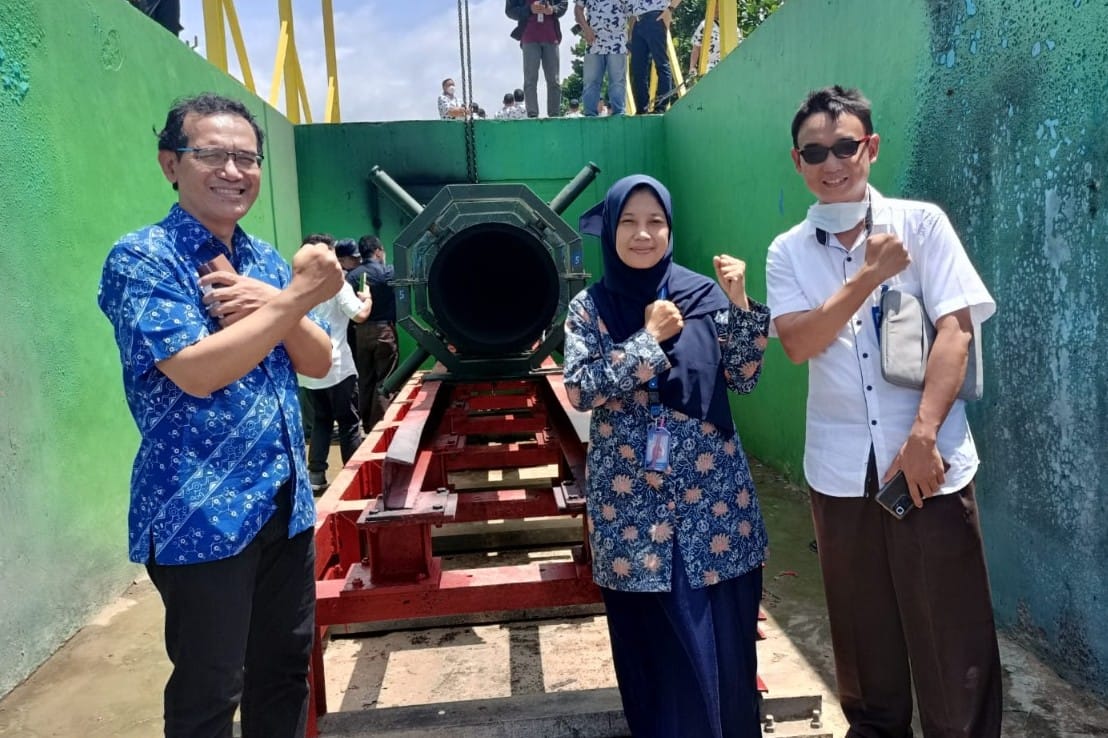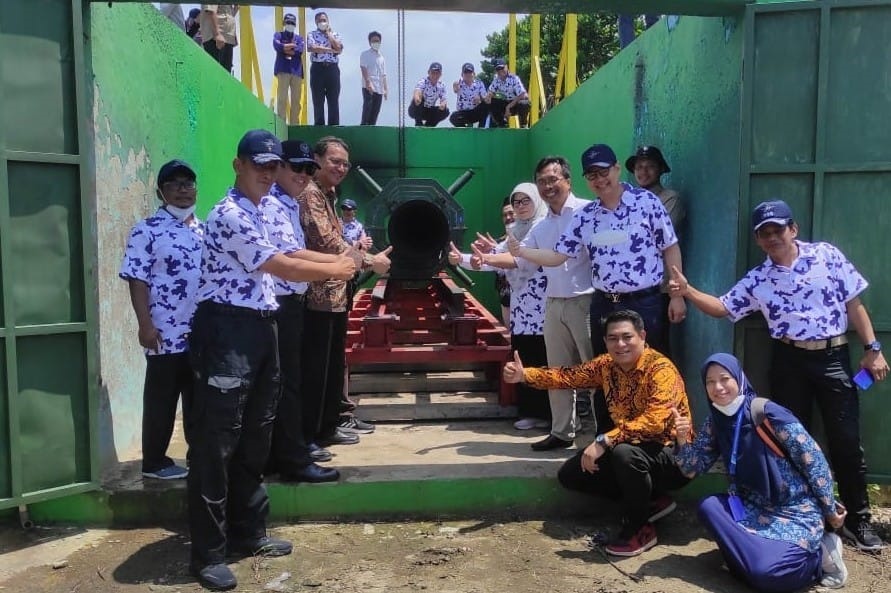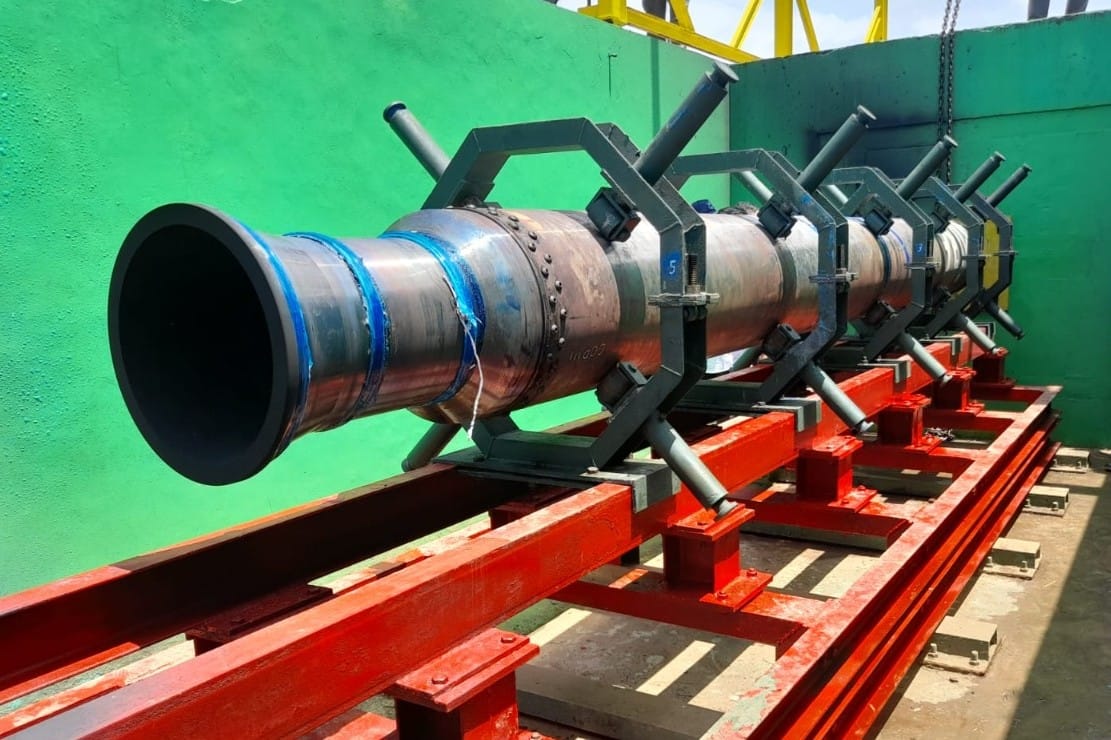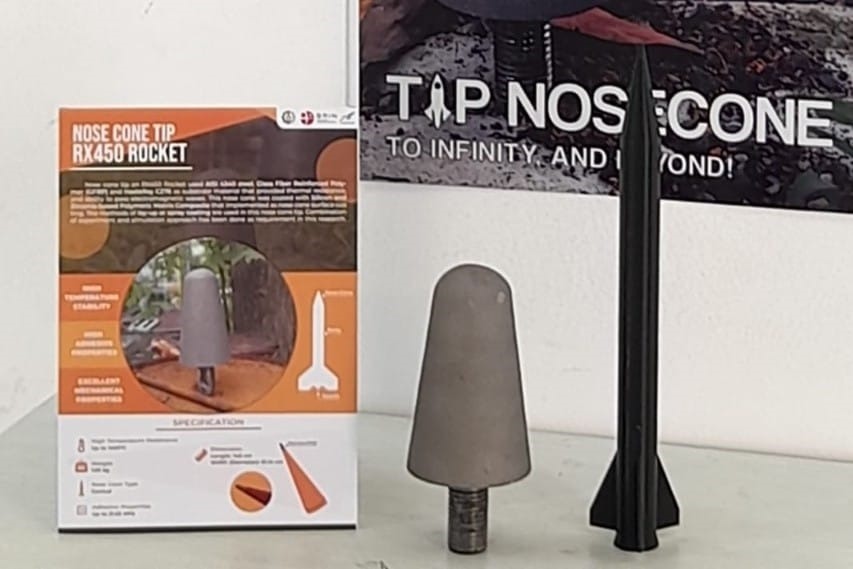ITS Participates in Developing and Testing Rocket Made in Indonesia

ITS research team (from left) Prof. Hamzah Fansuri SSi MSi Ph.D., Dr. Widyastuti SSi MSi, and Alief Wikarta ST MSc Eng Ph.D. attending a static test event and flight test of a rocket made in Indonesia
ITS Campus, ITS News – Institut Teknologi Sepuluh Nopember (ITS) is again taking on a role in the development of innovations carried out by the Indonesian people. This time, ITS participated in the development of a material technology for the 450 mm caliber rocket nosecone. Then, ITS also received an invitation from the Rocket Technology Research Center of the National Research and Innovation Agency (BRIN) to observe the R-Han 450 static test and RX200-TC flight tests which were carried out in the Garut Space and Atmospheric Technology and Observation Test Area, BRIN, Garut Regency, West Java.
Defense and experimental rocket testing was carried out to determine the capacity of several parts of the rocket that had been developed previously. This test was carried out together with a joint team from the Ministry of Defense’s Alpalhan Balitbang Center for Research and Development, PT Dahana, and the Rocket Technology Research Center, which is part of the Aviation and Space Research Organization (ORPA) – National Research and Innovation Agency (BRIN).
Deputy Head of the Research Center for Internet of Thing and Defense Technology (IoTTP) Directorate of Research and Community Service (DRPM) ITS Dr. Widyastuti SSi MSi said that static testing of the R-Han 450, which was carried out last October focused on propulsion and structural performance, especially on components of rocket tubes and nozzles. In this static test, the rocket motor is locked above the test bed, the fuel inside the rocket tube is burned, and operating conditions are imposed.

The ITS team of lecturers and researchers, along with the joint team from the Research and Development Ministry of Defense, ORPA, BRIN, and PT Dahana, when holding a static test of the R-Han 450 and a flight test of the RX200-TC
From this test, observations were made to determine the structural performance, thrust, combustion chamber pressure, combustion time, and other parameters of the latest R-Han 450 rocket. On the following day, activities continued with the launch of the RX200-TC. However, due to communication problems between the rocket avionics system and the ground station, the flight test of the experimental rocket had to be postponed, and a re-launch test was carried out at Karang Papak Beach, Garut, on December 21.
Not only following the trials, but Widya also said that two ITS teams were involved in developing critical technologies for defense rockets. The first team is the Innovation Research Team for Advanced Indonesia (RIIM) which received development funds from BRIN and the Education Fund Management Institute (LPDP). The team focused on developing the R-Han 450 nosecone tip material made from Thermal Barrier Coating (TBC), which does not interfere with telemetry. The development was funded by BRIN and the Education Fund Management Agency (LPDP).

Preparation for static tests on the R-Han 450 defense rocket, which was carried out at BUTPAAG-LAPAN
The second team from ITS consisted of Prof. Hamzah Fansuri SSi MSi Ph.D. and Alief Wikarta ST MSc Eng Ph.D. The team is responsible for the LPDP Invitation Productive Research program regarding Extruded Double Base (EDB) Folding Fin Aerial Rocket (FFAR) 70 research. The main focus of this team is developing propellant or propellant material from the FFAR-70 rocket, which will be tested later in three studies.
Therefore, ITS participation in observing the testing of the two rockets was to be able to observe the static test and flight test processes for the preparation of the FFAR-70 EDB. “So one of the goals is to provide an overview to researchers during static and dynamic testing, which will later be applied to FFAR-70,” said the Department of Materials and Metallurgical Engineering ITS lecturer.
After testing this rocket, Widya hopes that in the future, the innovative products that have been researched and developed by ITS can be applied to natural defense and security products. “Hopefully, the R-Han 450 Tip Nosecone product that has been made and FFAR-70, which is being researched, can be useful for the Indonesian defense system,” he hoped.

ITS Nosecone tip with a length of 14 cm will be used on the R-Han 450 rocket
In line with that, the Head of the ORPA Rocket Technology Research Center – BRIN, Dr. Arif Nur Hakim MEng, said that universities are also needed to provide research and innovation as ITS is in the development of a nosecone tip which will be applied in the flight test of the R-Han 450 rocket at the end of this year. “We will welcome it if later ITS can become a center of excellence in rocket technology,” said Arif.
Furthermore, Arif said his party would invite several universities and industries to continue developing rockets such as the RX200-TC, which BRIN is currently developing. He also hopes that ITS can continue working together to innovate rocket technology. “Because, after all, we still need help from many people,” he said. (ITS Public Relations)
Reporter: Muhammad Aulia Zikra
Related News
-
ITS Wins 2024 Project Implementation Award for Commitment to Gender Implementation
ITS Campus, ITS News —Not only technology-oriented, Institut Teknologi Sepuluh Nopember (ITS) also show its commitment to support gender
February 08, 2023 23:02 -
ITS Professor Researched the Role of Human Integration in Sustainable Architecture
ITS Campus, ITS News –The developing era has an impact on many aspects of life, including in the field
February 08, 2023 23:02 -
ITS Sends Off Group for Joint Homecoming to 64 Destination Areas
ITS Campus, ITS News — Approaching Eid al-Fitr, the Sepuluh Nopember Institute of Technology (ITS) is once again facilitating academics who want
February 08, 2023 23:02 -
ITS Expert: IHSG Decline Has Significant Impact on Indonesian Economy
ITS Campus, ITS News — The decline in the Composite Stock Price Index (IHSG) by five percent on March 18,
February 08, 2023 23:02
